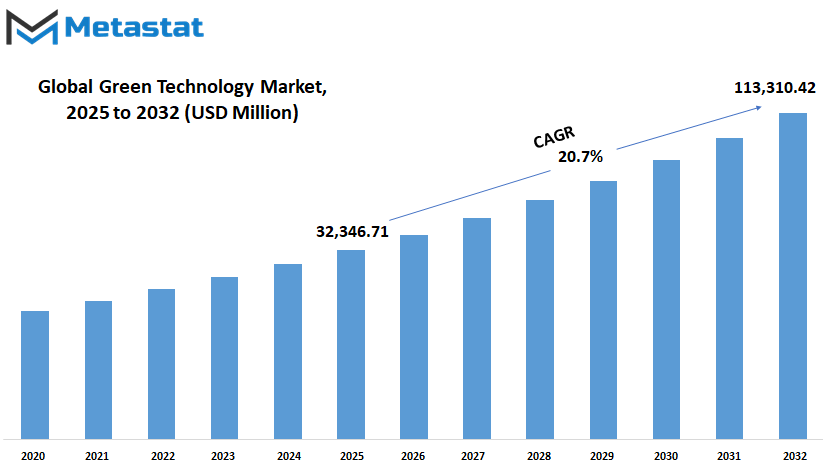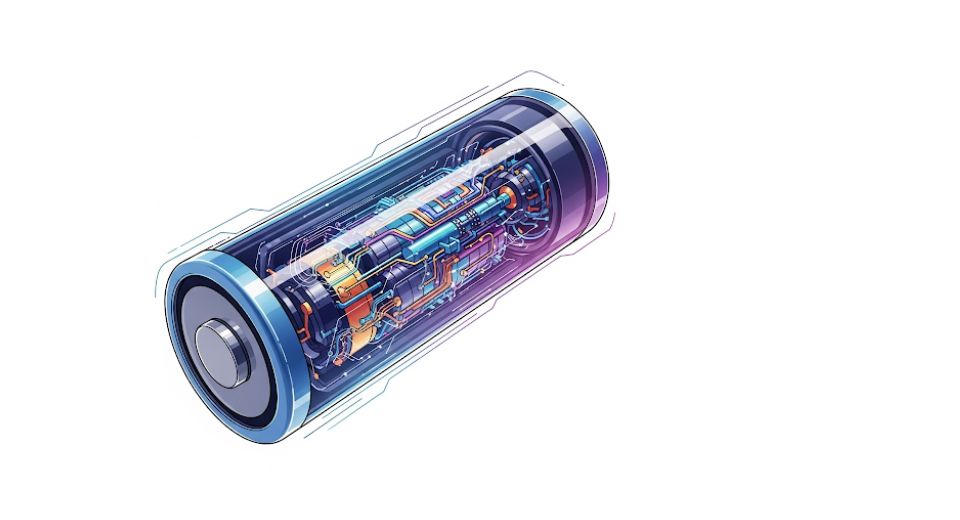MARKET OVERVIEW
The Global Green Technology Market has had an impact in the transformation of the environmental and sustainable innovations field. This will continue to impact how effective transformations across various sectors will be achieved, with a focus on clean resource-efficient solutions. All technologies that will be highlighted in this domain will be directed at developing, testing, and implementing tools and devices to mitigate environmental burdens, improve energy efficiency, and facilitate ecological sustenance in the future. The idea will not only manifest itself in environmental improvement impact areas but also in transforming the paradigm with which industries are known to operate under waste, emissions, and resource consumption.
At heart, the Global Green Technology market will trump systems and tools that minimize damage to natural ecosystems while supporting moving human and societal needs to an industrial contingent. All imaginable dependent on renewable energy platforms and carbon capture systems will include a cornucopia of renewable energy platforms as well as sustainable agricultural tools to eco-friendly manufacturing processes. As environmental concerns grow and pressures increase, many different stakeholders from energy through transportation and agriculture to construction will begin to blend their operations with such technologies.
The Global Green Technology market will see a wider application of industries positing performance and productivity unaltered along the quest for long-term sustainability. This will extend to renewable energy infrastructure, such as solar, wind, and hydro technologies, developed as part of the energy-storage-and-distribution improvements. As industry tries to replace fossil-fuel systems with something cleaner and more adaptable, this will shape both the investment patterns and the directions of research.
The Global Green Technology Market includes developments in battery design, smart grid integration, and electric and hydrogen-powered systems in the transportation sector, which could drive the change toward cleaner energy systems. This blueprint will reduce the need for non-renewable fuels, decreasing emissions from vehicular movement. In addition, farm yield will be affected by precision farming tools, such as satellite monitoring, efficient irrigation systems, and artificial intelligence in farm practices, while enabling responsible land use.
Emerging transformations under the Global Green Technology market will also comprise waste management and recycling systems where smart monitoring and automation can further streamline activities. Water purification and conservation systems will increasingly rely on sensor-based and filtration innovation geared toward resource conservation for clean water. Pockets of regions face increasing water scarcity challenges; hence, the level of demand for such solutions will keep increasing.
Building and urban planning will be significantly defined by the Global Green Technology market. Innovations in materials for construction, passive design systems, and tools for smart energy management will shape future architecture. Urban environments are increasingly adopting integrated green technology platforms to ensure livability.
Global Green Technology market is estimated to reach $113,310.42 Million by 2032; growing at a CAGR of 20.7% from 2025 to 2032.

GROWTH FACTORS
The Global Green Technology market has been witnessing its fame in leaps and bounds in recent times owing to increasing environmental concerns and worldwide carbon neutrality drive. All these trends witness sustainability as gradually being drama in general because, as awareness about climate change increases, it becomes necessary for governments and businesses worldwide to find alternative energy sources and industrial practices. The participation of society in various public and private campaigns is gaining ground for setting up necessary arrangements for the clean energy revolution, which is now a necessity and no longer a trend. It establishes policies and incentives for various countries on encouraging investments in renewable energy technologies such as solar, wind, and bioenergy. All these initiatives aimed at the reduction of carbon emissions and minimizing environmental impacts by industries will therefore accelerate growth in the green technology sector.
The outlook is promising, however, several bottlenecks can stall the growth of the market. One of the most significant hindrances is the burden of high upfront investment costs in putting up green technology infrastructure. The development and installation process requires hefty investment upfront, including up-front capital funding, for renewable energy systems and green technologies. More to this, research and development in this area requires further massive capital investments, making the operating environment difficult for businesses and governments. Such factors can dissuade players in joining fully from the adoption of green technologies, especially where costs of clean energy are high as compared to traditional energy sources.
Furthermore, another factor that impedes growth is limited scalability and performance gaps in certain green solutions. Green technologies have indeed achieved remarkable improvements but still have requirements that do not match standard energy systems in certain elements like reliability, efficiency, and output. In addition, some renewable energy resources, such as the sun and wind, cannot control its energy generation due to inconsistent weather conditions. So, continuous innovations and enhanced technologies, along with a better infrastructure invested in them, will overcome such restrictions.
Indeed, all of this is a challenge for the future of the Global Green Technology market because the future of this market looks very bright. In fact, governments will keep on pushing for sustainability. Investments in renewable energy solutions will also be on the upside, which will open doors to new improved opportunities. This presents a very attractive avenue for the market: increasing interest in the circular economy, carbon capture technologies, and sustainable innovation. Thus, companies that are focused on the development of solutions that either reuse resources or result in lesser waste will specifically benefit from this transition. Demand for clean energy and practices that are sustainable will keep on intensifying, making the path for this market favorably healthy in the years to come.
MARKET SEGMENTATION
By Deployment
In keeping with the future definition of industries concerning sustainability and environmental responsibility, the Global Green Technology market is progressing quite rapidly. Global warming and depletion of resources are growing concerns, becoming the paramount priorities for business and government alike, to seek for solutions to mitigate their environmental impact. Green technology is at the heart of this whole transition, providing new means of producing, consuming, and managing energy more efficiently and cleanly. Cleaner technologies are helping industries abandon traditional methods of operation dependent on fossil fuels, in favor of sustainable energy sources, energy-efficient devices, and sustainable practices. To a greater extent, this shift toward green technology is no longer a fad; it is surely a giant step that needs to be taken in ensuring a livable planet for its inhabitants.
Deploying those solutions is one of the key areas within the Global Green Technology market, and deployment can be divided into two major types: Cloud-based deployment and On-Premise deployment. With its flexibility, scalability, and cost-effective nature, Cloud-based deployment is quickly gaining attention in the market. With the benefit of cloud platforms, organizations can truly access these green technologies without having to make huge investments in physical infrastructure. This makes sustainable practices easy to implement into their current work processes with the option to simply scale them up or down as needed. Cloud-based systems also have the resource of remote monitoring and management, thus providing an easy way to track energy consumption for reducing waste and optimizing resource utilization. With their data centralized on the cloud, partners are easily able to update and improve their green technology solutions over time.
The On-Premise deployment gives the organization more control by allowing them to manage the green technologies directly on their own infrastructure. This requires a higher setup and investment cost, which, however, is chosen for security and compliance reasons by many organizations. On-Premise solutions are the best-suited option for companies that require custom-made or specialized green technology solutions; hence, these can be designed precisely for the organization's need. With detailed real-time monitoring and control, these systems are essential to maximizing energy efficiency and minimizing carbon footprints.
As the Global Green Technology market continues to be expansive with the maturing of technology and the two deployment methods will shape the future of sustainable practice. This freedom of choice between Cloud-based and On-Premise deployments will enable organizations to select the most fitting solution for their unique needs, ultimately ensuring a more sustainable and eco-friendly future for us all.
By Technology
The Global Green Technology market is now a critical segment of the ongoing endeavor towards a sustainable future. From the little to the large, the masses understand the impacts of climate change, and thus there has been an increased demand for solutions through which they can minimize their footprint on the environment. The markets within this spectrum are diverse and vast, considering the myriad technologies meant to reduce carbon footprints and promote environmental conservation. Scanning through the technologies, there are some key players that are expected to define the market's future.
Among the most prominent segments in the Global Green Technology market is that of solar energy. Solar panels convert the sun's energy into electricity. These installations have become quite common sources of renewable energy production. The price of solar technology has continually decreased and hence becomes more affordable to both residential and commercial installations. With time, the technology continues to improve; thus, solar power will play a much larger role than it does today in catering to global energy demands.
Another main segment is wind energy. Wind turbines harness the power of the wind to generate electricity. Wind energy develops fast. Wind farms, onshore and offshore, are moving towards greater efficiency - as with the technology of wind, it is predicted that wind energy will become an even larger contributor to the global energy grid. Wind power will be one of the most important parts of it as countries work toward achieving renewable energy targets.
Even hydropower, which is among the oldest established renewable energy sources, is still a considerable part of that landscape. Hydropower uses the flow of water in generating electricity, and the scope of growth in this industry is still immense, especially in water-rich areas of the world. Some more effective turbines and energy storage systems will allow hydropower to continue being important in the global transition to clean energy.
Bioenergy, which is based on the process of energy generation from organic material, is also getting increasing attention. Traditional fossil fuels might be totally replaced by biomass, biogas, and biofuels, the potential alternatives of bioenergy, in several sectors, from transportation to heating. The technology itself is improving continuously in providing a renewable energy source, which can be tailor-made to local conditions.
Using geothermal energy means taking the heat the Earth has produced to establish electricity or provide heating. This technology is less common but has a high potential in geothermal activity areas, such as volcanic areas. With improvements in drilling and energy storage, one would expect geothermal energy to be more important in the next few years.
CCS Carbon Capture and Storage Technologies focus on capturing CO2 emissions by industrial processes& storing them into underground formations to prevent entering the atmosphere.
By Application
The Global Green Technology market is entering ascendency and experiencing rapid growth; with the emphasis now becoming conscious towards sustainable and eco-friendly solutions, the world moves ever closer to environmental crises, thus directing investments towards green technology applications that can alleviate the negative impact on the planet. These technologies focus on human health and wellness, integrating energy-efficient and low-emission alternatives into many industries. By innovating, the Global Green Technology market will do its part in combating such international challenges as climate change, resource depletion, and pollution.
In the immediate future, the Global Green Technology would be expected to grow at an even faster rate, with big progress expected in some key areas. Green building, which emphasizes the design and construction of energy-efficient and sustainable material-oriented buildings, is one of these areas. The green building movement has gained more traction as people and businesses realize more the importance of energy consumption reduction and waste minimization in the construction industry. Buildings constructed utilizing green building practices will contribute to environmental conservation by reducing energy bills, carbon emissions, and indoor air quality improvement.
Carbon footprint management is another key segment of the market. Increasing awareness regarding the dangers of excessive carbon emissions has led several companies and governments to search for ways to monitor, manage, and reduce their carbon footprints. Green technologies that assist in emissions monitoring and management will gain more significance in the near term, with tightening regulations on environmental standards from the global policy level. By employing sophisticated software and tools to monitor emissions, businesses will minimize environmental damage and accomplish sustainability goals, thereby ensuring their competitiveness in the environmental marketplace.
Monitoring air and water pollution is another critical area of the Global Green Technology market. With pollution levels on the brink of danger in many parts of the world, advanced technologies for monitoring and controlling air and water quality will be on high demand. Technologies that can actively measure pollution during its emission will play a critical role in the conservation of ecosystem and public health. As pollution-related concerns become more pressing, governments and private business sectors will probably increase investment in pollution-control technologies and monitoring.
Another futuristic sector benefiting the Global Green Technology market is weather monitoring and forecasting. Accurate weather forecasts will be necessary for anticipating natural disasters and adapting to climatic scenarios. The relevance of this technology will only strengthen with increased impacts of climate change, making it an inevitable warrantor for disaster preparedness and resource management.
|
Forecast Period |
2025-2032 |
|
Market Size in 2025 |
$32,346.71 million |
|
Market Size by 2032 |
$113,310.42 Million |
|
Growth Rate from 2025 to 2032 |
20.7% |
|
Base Year |
2024 |
|
Regions Covered |
North America, Europe, Asia-Pacific, South America, Middle East & Africa |
REGIONAL ANALYSIS
The Global Green Technology Market is projected to grow visibly across many regions of the globe, each characterized with its specific peculiarities and opportunities. Geography is essential in determining the growth of green technologies, where countries and regions adopt different approaches depending on their needs, resources, and environmental priorities.
Examples in North America would include the United States, Canada, and Mexico all progressing in the green technology sector. The U.S. has taken the lead towards developing renewable energy resources and promoting green technologies like solar power and electric vehicles. Canada has been stepping up on the green side with major investments in clean energy and green building technologies. Mexico, slightly lagging behind its two neighbors, is nonetheless catching up with innovations in energy efficiency and sustainable practices as climate action becomes more urgent.
Europe is another critical region within the global green technologies market wherein the European Union has prioritized sustainability, having countries like Germany, the UK, France, and Italy. Germany, for example, has long been one of the leaders in renewable energy development, from solar to wind energies. The UK and France have also made significant investments in the renewable and energy-efficient technologies. These nations stand to continue to power the green innovation technology, not only for their own interest but to advance the global goals of the environment.
An Asia-Pacific region describes green technologies booming markets led by China, India, Japan, and South Korea. China will remain a force to reckon with in renewable energy development for it has already become the world leader in solar panel production and electric vehicle manufacturing. India is poised for growth in green technologies, mostly in solar energy, due to ever-increasing energy demand and sustainable development commitments. Both Japan and South Korea are investing heavily in clean energy solutions, with the latter also focusing on green buildings and energy-efficient systems.
South America, with Brazil and Argentina as the market leaders, is beginning to consider the global green technology market. Brazil, being rich in natural resources, is focusing on bioenergy, hydropower, and sustainable agriculture, while Argentina is taking steps to finance energy-efficient infrastructure to minimize its carbon footprint. As such countries will continue to strengthen their dedication to sustainability, the green technology market is bound for a gradual rise in this region. Finally, the Middle East and Africa, in general, have regarded green technologies over time; however, the concept of sustainability is gradually beginning to garner attention here.
COMPETITIVE PLAYERS
Of all the established markets in the economy, the Global Green Technology market is one of the best and most transformative sectors in the modern economy. Pressing environmental challenges will, however, make that demand increasingly vast, to discover novel ways of reducing carbon footprints and energy consumption while promoting sustainability. It also indicates growth, demand, and necessity of addressing climate change and risks linked to it. Increasingly, governments, businesses, and individual customers' awareness and understanding of their environmental footprint have led to increased investments and development in the area of green technology.
The key contributors in the industry are the ones that determine the pace at which the market grows and innovates. Siemens AG, Schneider Electric, and Johnson Controls are among the top names leading the way by providing technologies that eligible companies may employ to optimize energy use and minimize waste. Solutions of these companies are meant to serve both environmental ends and economic growth through improved efficiency across various sectors including manufacturing, construction, and energy. Some of the companies worth mentioning are Tesla, Inc. and Ørsted A/S who are known for their innovations in renewable energy among countries.
An important part of increasing importance is cloud computing and data management in green technology. Businesses, like SAP and Oracle, offer services through such technologists and AWS to achieve more on sustainability goals by going to smart infrastructure and effective resource management. They partition smart cities, grid systems, and energy networks that use resources as efficiently and sustainably as possible. Including this will be the clean energy sector in which technology companies like Bloom Energy and ABB Ltd will specialize-fuel cells and electrical grids-that will be important for reduction of dependence on fossil fuels.
Therefore, as the global green technology industry keeps growing, in consideration of its promising future; it goes on with the growth of technological innovations that seem to keep reshaping industries everywhere. Countries will be inclined to investing in renewable energy sources, energy storage, and sustainable infrastructure to meet climate targets and lower carbon footprints. Major collaborations with startups in innovative partnerships are essential for taking solutions to the next level in the fight against climate change. Besides, companies such as Honeywell International Inc., Mitsubishi Electric Corporation, and BT Group are developing intelligent solutions optimally using energy for industrialized, commercialized, and residential sectors, making the shift toward a greener economy much easier.
The world will continue to make changes in the way it does everything towards reducing its environmental footprint. It is this process that will see the Green Technology market continue to expand and develop.
Green Technology Market Key Segments:
By Deployment
- Cloud
- On Premise
By Technology
- Solar Energy
- Wind Energy
- Hydropower
- Bioenergy
- Geothermal Energy
- Carbon Capture and Storage (CCS)
- Smart Grids
- Green Buildings
- Other
By Application
- Green Building
- Carbon Footprint Management
- Air and Water Pollution Monitoring
- Weather Monitoring and Forecast
- Crop Monitoring
- Other
Key Global Green Technology Industry Players
- Wolters Kluwer
- Siemens AG
- Schneider Electric
- Bloom Energy
- SAP
- Oracle
- AWS
- Johnson Controls
- Honeywell International Inc.
- Tesla, Inc.
- Ørsted A/S
- BT Group
- ABB Ltd.
- Acciona
- Mitsubishi Electric Corporation
- ENGIE
WHAT REPORT PROVIDES
- Full in-depth analysis of the parent Industry
- Important changes in market and its dynamics
- Segmentation details of the market
- Former, on-going, and projected market analysis in terms of volume and value
- Assessment of niche industry developments
- Market share analysis
- Key strategies of major players
- Emerging segments and regional growth potential








 US: +1 3023308252
US: +1 3023308252






